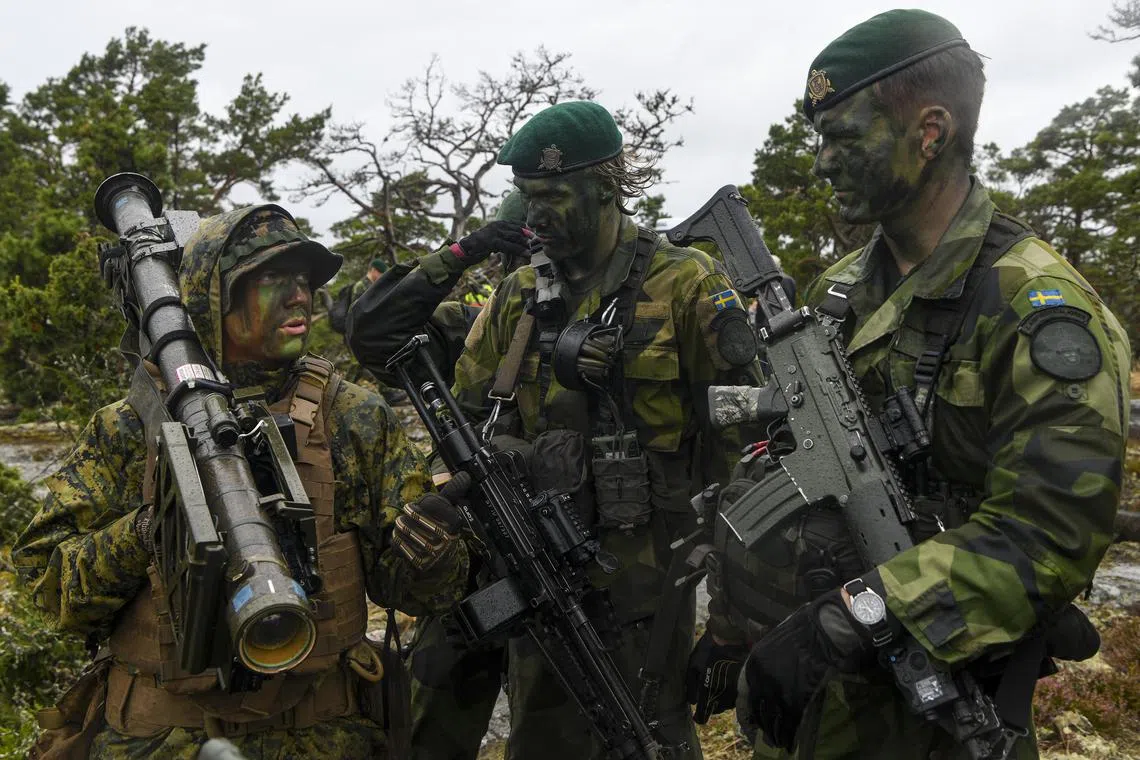How Russia pushed Finland and Sweden to join Nato
Sign up now: Get ST's newsletters delivered to your inbox

The Nato alliance’s expansion, with Finland in 2023 and soon Sweden, was a consequence from the invasion of Ukraine that Russia’s president may not have calculated.
PHOTO: NYTIMES
Follow topic:
HELSINKI/STOCKHOLM - Despite their orientations towards the United States and Western Europe, Finland and Sweden had bet that protecting their national security was best served by staying out of the North Atlantic Treaty Organisation (Nato).
They aimed to avoid disturbing the military balance in the Baltic Sea region and provoking Russia.
But those reservations were cast aside following Russia’s invasion of Ukraine,
Why didn’t Finland and Sweden join Nato earlier?
Both countries conducted military exercises with Nato and shared intelligence for years before applying.
They were also part of the alliance’s Partnership for Peace programme, which fosters cooperation, and, along with Ukraine, were among six so-called Enhanced Opportunity Partners that make “particularly significant contributions to Nato operations”.
But they did not join the alliance earlier for historical reasons.
Finland has spent the 106 years since its independence tiptoeing alongside Russia, with which it has roughly 1,300km of border.
Two wars against the Soviet Union between 1939 and 1944 were followed by a policy of deference and self-censorship towards the Soviets that came to be known as Finlandisation.
After the Cold War ended, Finland began turning more towards the democracies of Western Europe, joining the European Union and adopting the euro.
But the Finns held on to the cornerstone of their foreign policy: maintaining good relations with Russia. The ghost of Finlandisation lingered and popular opinion was firmly against joining, until 2022.
Sweden stayed out of both world wars and, during the Cold War, neutrality was seen as the best way of ensuring its independence.
Still, Sweden’s defence was designed to deter a Soviet invasion, and the country covertly cooperated with Nato.
After the collapse of the Soviet Union in 1991, Sweden’s policy was rebranded as military non-alignment, and its defence was significantly scaled down.
But since Russia’s 2014 annexation of Ukraine’s Crimea peninsula, Sweden has gradually ramped up military spending and sought closer cooperation with Nato.
What’s the benefit for Nato?
Having Finland and Sweden in the alliance arguably makes it easier to stabilise the security of the area around the Baltic Sea and to defend Nato members Estonia, Latvia and Lithuania.
The three small Baltic countries are often seen as a potential target for Russian aggression because they have substantial ethnic Russian minorities, and Russian President Putin has used protecting such groups as a pretext for interventions abroad.
The Baltics’ only land connection to the rest of Nato is the narrow Suwalki Gap, often considered the alliance’s weakest spot.
Finland and Sweden have sophisticated, well-equipped militaries with gear that is already compatible with that used by the alliance, while Finland’s long border with Russia should enable the alliance to improve its surveillance of the giant neighbour to the east.
What’s required to join Nato?
The criteria include a functioning democracy based on a market economy, fair treatment of minority populations, a commitment to resolve conflicts peacefully, and a willingness and ability to make a military contribution to Nato operations.
Sweden and Finland are among the world’s most developed nations, with stable democracies and highly trusted political institutions.
It is not a requirement that citizens bless a move to join, but favourable public opinion lends legitimacy to a country’s bid for membership.
It also must be ratified by all existing members.
Finland was approved relatively quickly, and joined on April 4, 2023,
Turkey finally signed off on Sweden’s entry in January, and Hungary followed on Feb 26, after both countries clinched deals to acquire fighter jets from Nato allies.
How has Russia responded to Finland and Sweden joining Nato?
Russia has warned of “serious military and political consequences” that would require it to respond.
In 2022, Russia said it would deploy nuclear weapons in and around the Baltic Sea region if the two joined.
Lithuanian President Gitanas Nauseda dismissed the threat as “empty”, accusing Russia of already placing tactical nuclear weapons in Kaliningrad, its exclave on the Baltic.
Before the Baltic States joined Nato in 2004, Russia had warned them of serious consequences, but that has not materialised.
On the other hand, Montenegro in 2016 said it had foiled a Russia-backed plan to assassinate then Premier Milo Djukanovic over the country’s plans to enter Nato, which happened a year later.
A court in 2019 sentenced 14 people, including opposition leaders and Russian and Serbian nationals, to as many as 15 years in jail over the failed plot, though an appeals court annulled the verdicts.
Before joining, Finns expected to face more spying, cyberattacks, airspace breaches and influence operations by Russia.
In November, Russia began an operation of weaponised immigration, sending asylum seekers to the border and prompting Finland to close all road crossings on the demarcation.
How is this changing Finland and Sweden?
They are increasing military cooperation bilaterally and with other nations – work that began to accelerate in the run-up to the war in Ukraine.
They signed defence cooperation agreements with the United States in late 2023, after the US in 2023 made security assurances to both applicants if threatened by Russia.
Nato’s pledge of collective defence applies to members.
They have also signed security cooperation agreements with Britain and both intend to continue ramping up defence spending, with Sweden set to meet Nato’s guideline expenditure of at least 2 per cent of national gross domestic product in 2024. BLOOMBERG

